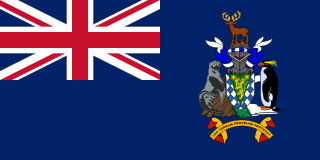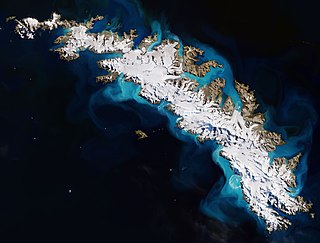Related Research Articles

South Georgia and the South Sandwich Islands (SGSSI) is a British Overseas Territory in the southern Atlantic Ocean. It is a remote and inhospitable collection of islands, consisting of South Georgia and a chain of smaller islands known as the South Sandwich Islands. South Georgia is 165 kilometres (103 mi) long and 35 kilometres (22 mi) wide and is by far the largest island in the territory. The South Sandwich Islands lie about 700 kilometres (430 mi) southeast of South Georgia. The territory's total land area is 3,903 km2 (1,507 sq mi). The Falkland Islands are about 1,300 kilometres (810 mi) west from its nearest point.

Quercus garryana is an oak tree species of the Pacific Northwest, with a range stretching from southern California to southwestern British Columbia. It is commonly known as the Garry Oak, Oregon white oak or Oregon oak. It grows from sea level to an altitude of 690 feet in the northern part of its range, and from 980 to 5,900 ft in the south of the range in California. The eponymous Nicholas Garry was deputy governor of the Hudson's Bay Company.

South Georgia is an island in the South Atlantic Ocean that is part of the British Overseas Territory of South Georgia and the South Sandwich Islands. It lies around 1,400 kilometres (870 mi) east of the Falkland Islands. Stretching in the east–west direction, South Georgia is around 170 kilometres (106 mi) long and has a maximum width of 35 kilometres (22 mi). The terrain is mountainous, with the central ridge rising to 2,935 metres (9,629 ft) at Mount Paget. The northern coast is indented with numerous bays and fjords, serving as good harbours.


Poa flabellata, commonly known as tussac grass or just tussac, is a tussock grass native to southern South America, the Falkland Islands, South Georgia and other islands in the South Atlantic. There are also two isolated records from the herbarium at the French Muséum national d'histoire naturelle for the Île Amsterdam in the Indian Ocean.

Allium canadense, the Canada onion, Canadian garlic, wild garlic, meadow garlic and wild onion is a perennial plant native to eastern North America from Texas to Florida to New Brunswick to Montana. The species is also cultivated in other regions as an ornamental and as a garden culinary herb. The plant is also reportedly naturalized in Cuba.

The ecological restoration of islands, or island restoration, is the application of the principles of ecological restoration to islands and island groups. Islands, due to their isolation, are home to many of the world's endemic species, as well as important breeding grounds for seabirds and some marine mammals. Their ecosystems are also very vulnerable to human disturbance and particularly to introduced species, due to their small size. Island groups such as New Zealand and Hawaii have undergone substantial extinctions and losses of habitat. Since the 1950s several organisations and government agencies around the world have worked to restore islands to their original states; New Zealand has used them to hold natural populations of species that would otherwise be unable to survive in the wild. The principal components of island restoration are the removal of introduced species and the reintroduction of native species.

Ribes sanguineum, the flowering currant, redflower currant, red-flowering currant, or red currant is a North American species of flowering plant in the family Grossulariaceae, native to the western United States and Canada.

Gunnera tinctoria, known as giant rhubarb, Chilean rhubarb, or nalca, is a flowering plant species native to southern Chile and neighboring zones in Argentina. It is unrelated to rhubarb, as the two plants belong to different orders, but looks similar from a distance and has similar culinary uses. It is a large-leaved perennial plant that grows to more than two metres tall. It has been introduced to many parts of the world as an ornamental plant. In some countries, such as New Zealand, the United Kingdom and Ireland, it has spread from gardens and is becoming an introduced species of concern. It is known under the synonyms: Gunnera chilensis Lam. and Gunnera scabra Ruiz & Pav.

Trillium rugelii, also known as the southern nodding trillium or illscented wakerobin, is a species of flowering plant in the family Melanthiaceae. It is native to parts of the southeastern United States. It is found in the Great Smoky Mountains, Fernbank Forest, Steven's Creek Heritage Preserve, and other places of the Piedmont and southern Appalachian Mountains in Alabama, Georgia, South Carolina, North Carolina and Tennessee. It prefers to grow near streams in humus-rich soil under the shade of deciduous trees.

Lysichiton americanus, also called western skunk cabbage (US), yellow skunk cabbage (UK), American skunk-cabbage or swamp lantern, is a plant found in swamps and wet woods, along streams and in other wet areas of the Pacific Northwest, where it is one of the few native species in the arum family.

Arctium minus, commonly known as lesser burdock, little burdock, louse-bur, common burdock, button-bur, cuckoo-button, or wild rhubarb, is a biennial plant. This plant is native to Europe, but has become introduced elsewhere such as Australia, North and South America, and other places.

The Scotia Sea Islands tundra is a tundra ecoregion which includes several island groups – South Georgia and the South Sandwich Islands, South Shetland Islands, and Bouvet Island – in the Scotia Sea, where the South Atlantic Ocean meets the Southern Ocean. Most of the terrain is covered with snow and permanent ice, with tundra vegetation - moss, lichen, and algae - on the remainder. The islands support important rookeries for seals, seabirds, and penguins. The islands have no permanent human habitation, and the cold, harsh climate and ending of seal hunting and whaling has prevented settlement.

Erythronium grandiflorum is a North American species of plants in the lily family. It is known by several common names, including yellow avalanche lily, glacier lily, and dogtooth fawn lily. The Ktunaxa name for glacier lily is maxa.

The flora of Australia comprises a vast assemblage of plant species estimated to over 21,000 vascular and 14,000 non-vascular plants, 250,000 species of fungi and over 3,000 lichens. The flora has strong affinities with the flora of Gondwana, and below the family level has a highly endemic angiosperm flora whose diversity was shaped by the effects of continental drift and climate change since the Cretaceous. Prominent features of the Australian flora are adaptations to aridity and fire which include scleromorphy and serotiny. These adaptations are common in species from the large and well-known families Proteaceae (Banksia), Myrtaceae, and Fabaceae.
Wilbur Howard Duncan was a botany professor at the University of Georgia for 40 years where he oversaw an expansion in the school's herbarium collection and described three new plant species. Duncan also authored several books on plant species of the Eastern and Southeastern United States.

Stellaria apetala, lesser chickweed, is an annual herbaceous plant in the flowering plant family Caryophyllaceae. It occurs in short, sandy grassland by the sea and, less often, in similar habitat inland. It is native to Europe and is well established as an introduced species worldwide.

The wildlife of the Falkland Islands is quite similar to that of Patagonia. The Falkland Islands have no native reptiles or amphibians, and the only native land mammal, the warrah, is now extinct. However, a large number of bird species have been seen around the islands, and many of them breed on the smaller islands of the archipelago. Insects play a large role in the ecosystem of the islands, and over 200 species have been recorded. The waters around the Falkland Islands sustain many animals, including a large number of marine mammals. Three pinniped species breed on the islands.

Agrostis vinealis is a species of grass known by the common names brown bentgrass and brown bent, which can be found from Russia to Mongolia, China, Pakistan, India and Alaska. It was introduced to Greenland and South Georgia and the South Sandwich Islands.

The flora of French Polynesia refers to the native vegetation of the Marquesas Islands, the Tuamotu Archipelago, the Society Islands and the Tubuai Islands, located in Oceania. Due to its type of vegetation, French Polynesia falls within the palaeotropic floral kingdom.
References
- ↑ "Terrestrial flora of South Georgia and Antarctica" (PDF). British Antarctic Survey (BAS). Retrieved 3 October 2019.
- ↑ "Terrestrial/Plants – Government of South Georgia & the South Sandwich Islands" . Retrieved 3 October 2019.
South Georgia is home to just 25 species of native vascular plant, none of which are endemic. The poorly developed vascular plant flora is probably as a consequence of the island's isolation from major landmasses and the relatively harsh year-round climate. In contrast there are around 125 species of moss, 85 liverworts and more than 200 species of lichen.
- 1 2 3 Upson, Rebecca; Myer, Bradley; Floyd, Kelvin; Lee, Jennifer; Clubbe, Colin (2017). Field guide to the introduced flora of South Georgia. Richmond, Surrey, UK: Kew Publishing, Royal Botanic Gardens. ISBN 978-1-84246-652-0. OCLC 1007331209.
- 1 2 Galbraith, Deirdre. (2011). A field guide to the flora of South Georgia. Great Britain: South Georgia Heritage Trust. ISBN 978-0-9564546-0-7. OCLC 714041780.
- 1 2 3 "South Georgia Flora Guide". 18 January 2021.
{{cite web}}: CS1 maint: url-status (link)